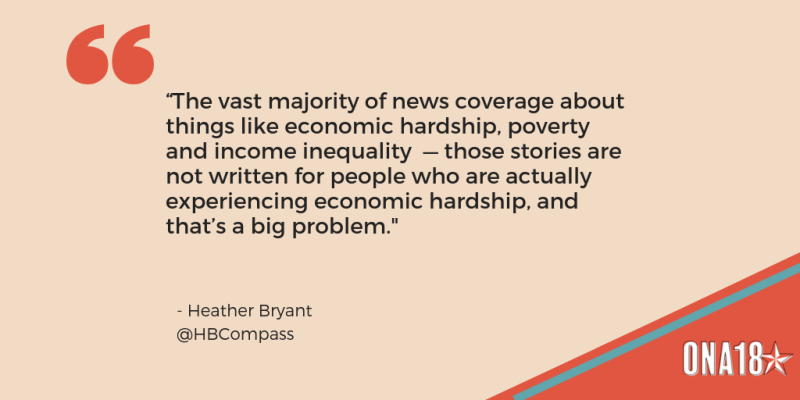
The lack of class diversity in journalism was nothing new to Project Facet Director Heather Bryant.
She grew up in the Midwest, where her grandmother raised three children on just $700 each month. But Bryant was surprised at the reactions she received at a conference last summer from others in the industry, when they learned that her husband drove a garbage truck.
”There was kind of a … clear surprise, disapproval and judgment about it,” Bryant said.
The experience didn’t sit well with her, and she chronicled her feelings in a well-read Medium post.
“It doesn’t really make sense to think less of him because of his occupation – especially if you’re in journalism,” Bryant said.
Bryant believes that journalists should be aiming to serve all people who are in need, and she is now focused on how news organizations can better serve low-income communities: reporting for them, instead of merely reporting on them.
“The vast majority of news coverage about things like economic hardship, poverty and income inequality — those stories are not written for people who are actually experiencing economic hardship, and that’s a big problem,” Bryant said.
Bryant recalls that when she was growing up, newspapers were useful for only three things—the classifieds, the police blotter and the obituaries. Now, she wants news organizations to do more.
Bryant points to the lack of socioeconomic diversity of reporters in newsrooms as the start of the problem. As the industry prioritizes career professionals who likely come from more privileged backgrounds, Bryant said reporters have to work harder to cover economically diverse communities, since those who understand different experiences are often missing from the conversation.
Ashley Alvarado, director of community engagement at 89.3 KPCC and LAist, said that when reporters miss the mark, it is painfully obvious.
In Los Angeles, libraries serve as public gathering places that offer social services such as children’s programs and job resources. When KPCC was working on a piece about the invisible homeless population, the outlet made sure their work was accessible in the libraries often used by those homeless people.
“We also have to rethink distribution models,” Alvarado said. “We looked at how do we get this story to policy makers, but also to those people who are actually experiencing it.”
When she was at the Center for Investigative Reporting, Alvarado searched for resources to inform young students about how to survive an earthquake in outdated California schools.
Alvarado asked which communities would be the most affected and what they needed to know. Since she wanted to make her findings accessible to children, she created an informative coloring book where they could learn about safety tips like “drop” or “take cover.”
Alvarado found an intersection between a need for crisis preparation and making it widely available for children. She ordered a small amount of books at launch, but eventually, schools across the state were requesting copies of Alvarado’s coloring books. Alvarado created content people could use and prioritized making it readily available.
People in the news community believe that people don’t want to pay for reporting, but Bryant said we cannot expect people to pay if we can’t help them, especially those who are low-income.
“We have to start talking about ways to include them: How do we include them in a way that’s not exploitive or dehumanizing?” Bryant said.







You must be logged in to post a comment.